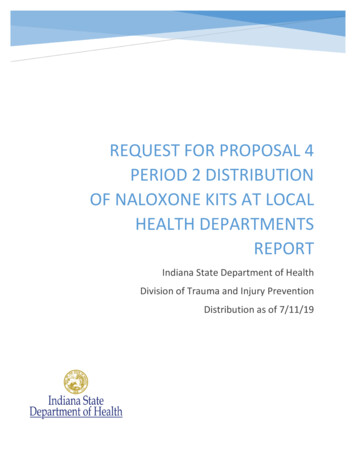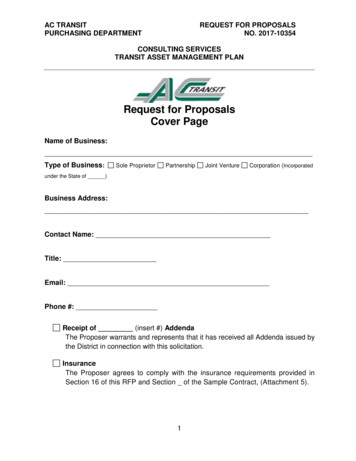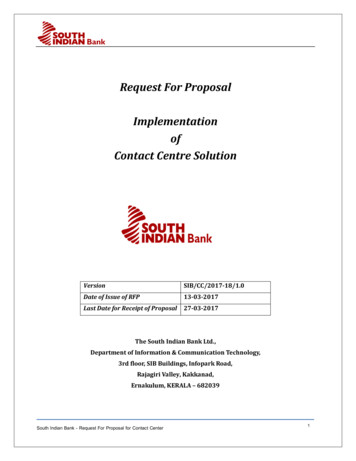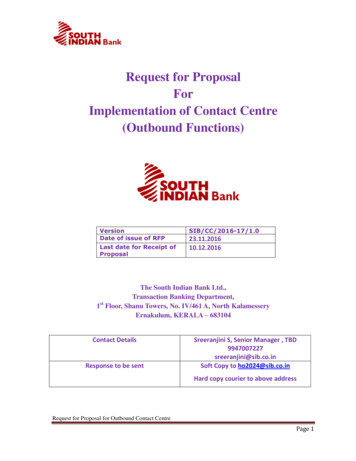
Transcription
REQUEST FOR PROPOSAL 4PERIOD 2 DISTRIBUTIONOF NALOXONE KITS AT LOCALHEALTH DEPARTMENTSREPORTIndiana State Department of HealthDivision of Trauma and Injury PreventionDistribution as of 7/11/19
Table of ContentsBackground . 2Methods . 2Results . 0Discussion. 91
BackgroundIndiana ranks 16th in opioid-related deaths in the United States as of 2016. This high ranking in opioidrelated deaths is in part a result of the rise in opioid-based prescription drug overdoses in Indiana andacross the nation. The most common drugs involved in prescription drug overdose deaths includehydrocodone (e.g., Vicodin), oxycodone (e.g., OxyContin), oxymorphone (e.g., Opana), and methadone(especially when prescribed for pain). Naloxone is a safe, non-addictive medication that inhibits theeffects of opioid overdose and allows regular breathing to resume.A Memorandum of Understanding (MOU) was created between the Family and Social ServicesAdministration Division of Mental Health and Addiction (DMHA) and the Indiana State Department ofHealth (ISDH) for the purpose of delegating funds to increase the training and distribution of naloxone incommunities. This MOU was effective between April 16, 2018 and December 31, 2018. The fundsprovided by DMHA were regulated for use under the following conditions: ISDH would gather anddistribute naloxone kits to local health departments, as well as perform period reporting of whoreceived treatment, the number of naloxone kits distributed, and the number of kits used across thestate.MethodsTo meet the MOU requirements, ISDH sent out a Request for Proposal (RFP) to local health departments(LHDs) to provide education and distribute naloxone in their respective communities. The RFP describesthe ISDH efforts and requirements for expanding the distribution of naloxone kits. The dates forimplementing the RFP were set for April 16, 2018 through December 31, 2018. The period reportingschedule is: 1st report (April 16, 2018 – June 30, 2018) prior to July 31, 2018.2nd report (July 1, 2018 – September 30, 2018) prior to October 31, 2018.3rd report (October 1, 2018 – December 31, 2018) prior to January 31, 2019.Reports will be expected until all kits are distributed.Forty-one LHDs across the state applied and were accepted for the naloxone kit distribution program:Allen, Bartholomew, Blackford, Boone, Brown, Cass, Clark, Clinton, Elkhart, Fayette, Floyd, Greene,Hamilton, Hendricks, Howard, Jackson, Jefferson, Jennings, Johnson, Kosciusko, Lake, LaPorte, Madison,Marshall, Miami, Monroe, Montgomery, Morgan, Ohio, Orange, Perry, Porter, Posey, Ripley, Scott,Spencer, Tippecanoe, Vanderburgh, Vermillion, Wells, and Whitley counties. The location anddistribution of the counties are depicted as the highlighted counties in Figure 1. Each LHD was given adifferent number of kits based on the number of kits requested by the health department. Priority wasgiven to high-burden counties depicted in Figure 2. The ISDH provided a total of 1,143 kits to the 41participating LHDs (Figure 3).2
Figure 1: Map of local health departments selected for naloxone kit distribution in RFP 4Figure 1 shows a map of counties which have local health departments participating in the second round of naloxone kitdistribution. These counties are highlighted in blue.3
Figure 2: Map of prescription drug overdose priority counties through Indiana’s Prescription DrugOverdose Prevention for States ProgramFigure 2 shows a map of counties that are considered priority for preventing prescription drug overdose through Indiana’sPrescription Drug Overdose Prevention for States program. These counties are highlighted in blue. The Prevention for Statesprogram is a part of the Centers for Disease Control and Prevention’s (CDC) ongoing efforts to scale up prevention activities aspart of a national response to the opioid overdose epidemic. Prevention for States provides resources and support to advancecomprehensive state-level interventions for preventing prescription drug overuse, misuse, abuse and overdose.4
Figure 3: Total number of naloxone kits given to local health departments by the Indiana State Department of Health1600150015001400120012001200Number of Kits10921000841800708583600514432 425400340306250 240 240206 200 200 200200180 180 156150 150 150 150100 100 100 95 85 80 7566 6025 22 26 10 cksonTippecanoeScottLakeMonroe0Local Health DepartmentsFigure 3 depicts the total number of naloxone kits that were given by the Division of Trauma and Injury Prevention at the Indiana State Department of Health to the 41 LHDs. The Lake andMonroe County Health Departments received the most kits (N 1500) while the Perry County Health Department received the smallest number (N 6).
Results:All 41 LHDs reported a total of 2,611 kits distributed for period 2, as of 10/31/18. There are some general trends from the reporting counties. Allen andMonroe counties were able to distribute the most kits with a combined total of 567 kits distributed in the second period. Figure 4 illustrates the numberof kits distributed during period 2 by each participating health department.Figure 4: Number of naloxone kits 48124107106927968 6353 51 50 4840 3627 22 2112 11 10 8 8 63 3 1 0 0 0 0 0 0 0 0 ksKosciuskoMorganOhioPerryScottNumber of KitsFigure 4 shows thenumber of kitsdistributed by LHDsto their communitiesduring period 2. Themost kits weredistributed from AllenCounty (N 300) andMonroe County closebehind (N 267). Theleast number of kitsdistributed were fromBlackford, Boone,Cass, Kosciusko,Morgan, Ohio, Perry,and Scott counties atzero. Cass and Scottcounties did notreport distributiondata for round 2.Local Health DepartmentsNumber of Kits Distributed
Table 1: Services co-offered, partner agencies involved in training and naloxone training outreach atLHDsLocal ices Co-offeredKits distributed to the partner agency Allen County SSPclients' services include:Hep A immunizations, healthnavigation for healthcare coverage; on-site SUDtreatment intakes; HIV/HCV testing; MH counselingreferrals; wound care & health assessments; heathcarereferralsPartner Agencies Involved WithTraining and Distribution of NaloxoneKitsNaloxone Training Outreach MethodsNo changes from our initial training anddistribution planEmail and community requestsColumbus Christian School, White CreakLuthern School, Bartholomew CountySchool Corporation, Centerstone, RecoveryEngagement Center, Life Works IOP,Bartholomew County Sheriffs Dept,German Township Fire Dept, ElizabethtownAll agencies still have previous handouts from firstVolunteer Fire Dept, Columbus Townshipdistribution period. Postcards and Postcard surveyFire Dept, Southwest Fire Dept, WayneEmail was sent to all participating local partnerinstructions given. Immunization information for FirstTownship Fire Dept, Hope Fire Dept,agencies. Those that did not respond from emailResponders and Are You Up to Date brochure given to all Clifford Fire Dept, Hartsville Township Fire was called.agencies to share with their organization.Dept, Lincoln Central Neighborhood FamilyCenter, YES Cinema, Salvation Army,Celebrate Recovery, Youth Services,Community Corrections/ResidentialCenter, Harrison Township Volunteer FireDept, Bartholomew County Health Dept,Clay Township Fire Dept.N/RN/RN/RSame PartnersN/RN/RCommon s/s of Opioid overdose flyer, business card forHealth Department, Health Department Flyer on CPRclasses, Health Department Flyer on Sharps ContainersDisposal Program, Health Department Flyer on OpioidRescue Kit Program, Opiate Addiction Treatmentinformation, Community Mental Health Centersinformation, Substance Abuse Resource informationsheet, Parents of Addicted Loved Ones Flyer, SuicidePrevention Lifeline Flyer, Narcan Quick Start Guide,secondary Naloxone administration information sheet,Centerstone informationOur only distribution location currently,besides the Health Department itself, isCenterstone. The Women's ResourceCenter was going to be a distributionlocation but the director said she iscurrently working with ISDH on getting onthe list on optin.in.gov. I have gotten intouch with the director of the centermultiple times and offered to come to herto help her or for her to come into theHealth Department (to enroll). She hasdone neither.Brown County Health Department website, flyers,newspaper, word of mouth, Brown County DrugFree Coalition, School Corporation social media,Advisory Subcommittee to the Health Board onOpioids, community contactsCassN/RN/RN/RClarkNumerous flyers for treatment resources and supportgroups, medical and/or substance abuse treatmentreferrals to LifeSpring Health Systems/Turning Point,Wellstone and Family Health Center of So. Indiana, freeClark Memorial Hospital, Clark CountyHIV and HepC testing, PrEP in partnership with LifeSpringCARES, LifeSpring Health SystemsHealth Systems, free TB testing for those enteringrehab/treatment at Turning Point, referrals for MAT toSo. IN Treatment Center, insurance sign up at C.A.S.I.,food and clothing referrals to Bliss House.BrownClintonWe offer list for Treatment resources; Our newestresource guide Roadway to Recovery has been widelyapplauded as a more direct resource guide for ourcommunity, Suicide Prevention Line, Resource list oftreatment agencies, assistance with getting Medicaidecoverage.The Health Department can arrange HIV andHepatitis C testing, groups offering support for familymembers, follow-up, education, additional counselingreferrals.Outreach methods include social media, flyers,newpaper, word of mouth, billboards andcommunity contacts.This grant period we are concentrating ourefforts on small incorporated towns in ourcounty outside of the Frankfort city area.Our chossen partners will be the VolunteerFire Departments for each community.There are five (5) such incorporated townsWe utilize: Newspaper, flyers, Facebook, On-linein our county; Mulberry, Kirklin, Colfax,Newspaper, Social Media, Radio Talk Show,Michigantown, and Rossville. We willReferrals (word of mouth)partner with each Volunteer Fire Dept ineach small town to plan a traiining event.Our Long standing partner Clinton CountyEMS will assist with this year's grantactivities by assisting with contactingVolunteer Fire Departments.
ElkhartFayetteFloydGreeneThe plan is to educate the nurses in theElkhart Community Schools(ECS) systemand tran and distribute the Naloxone. Stilljust ECS and ECHDPartner agencies are Connersville PoliceTreatment resources, Resource list of treatmentDepartment, Fayette County EMS, Fayetteagencies, HIV and Hepatis C testing, support for familyCounty Sheriff's Deaprtment, Fayettemembers, follow-up, education, addition counselingCounty Community Corrections, Fayettereferrals, and etc.County Public Library and The Haven, FRHSSyringe exchange, harm reduction supplies and(Fayette Regional Helath Systems)education, HIP 2.0 PE, vaccinations for HPV, Tdap, Hep BEmergency Department, North Starand Hep A, Referrals to services, testing for HIV and HepRecovery and Fayette Regional OutpatientCServices.Treatment resources locally, list of agencies, counselingservices locallyPrearranged targeted grant for ECS. No other localschools interested.Newspapers, flyers, Facebook, word of mouth,local TV3Resource information of agencies in area, HIV and Hep Ctesting information, support for families -FamiliesEMS, Fire Departments, FamiliesAnonymous, Counceling services information,Anonymous, Life Springs, Hospitals.Educational materials.Word of mouth, Flyers, Facebook and localhospital.I include treatment resources, testing site information,and suicide prevention information.I have utitlized email to converse with mydifferent partner agencies.Greene County Health DepartmentHamiltonHamilton County Service Organizations,Good Samaritan Network, County Trustees,HIV/Hep C Testing, How to get rid of old decatenation,Local Law Enforcement Agencies and LocalTreatment Centers in Indiana. The Number to the Poison EMS Organizations, Community HospitalSocial Media, Facebook, Next Door, Twitter, FlyersCenter, Suicide Information, What to do with oldHome Care, St. Vincent Fishes Hospital and and Community partners.needles.Trinity Free Clinicm St.Vincent HosptialFishers, St. V EMS Education, SheridanLibaryHendricksN/RN/RN/RHowardTreatment resources; HCV, HIV, and STD testingresources, and harm reduction pamphletNo partner agencies were involved in thetraining and distribution of kits.Flyers, social media, contact cards, and word ofmouthJacksonN/RN/RN/RJeffersonHIV, Hep C, and STD testing/treatment/referrals/followup are also offered within our agency, although notnecessarily at the same time as Naloxone training.We have no new partners. However,established partners have started returningNewspaper, Facebook, Community contacts, andto obtain additional doses, due to eitherword of mouth.use or expiration of previously obtaineddoses.JenningsOpiate Addiction Treatment Centers List, Lifeline 1-800273-TALK, Community Mental Health Centers List, NasalSpray Quick Start Guide, Surveys, and What is Indiana'saaron's LawPartners remain unchangedCommunity outreach efforts and word of mouthhave proven to be effective distribution methodsin Jennings County.The JC Cares AddictionRecovery Resource Rally helped reach moreindividuals this timeby having it at the same timeand location as community churches were holdinga Revival.JohnsonN/AOur partner agencies have grown fromfirefighters to include school nurses andone police department.Email, community contacts, word of mouthKosciuskoN/RDiscussions about Naloxone availabilityand education were held with homelessshelter and any who called.N/RLakeWe are working with fire departments andEMTs to provide them with Narcan. We arealso looking to partner with the railroads toProvided SAFE's parent resource guide that hasprovide their employees with Narcantreatment organization's contract information, along withtrainings and Narcan for their first aid kits.Geminus Corporation's services/training inforamtion.We are also working with schools toprovide them training and provide Narcanfor their staff.Outreach methods included: Email, Flyerdistrbution at Vendor Fairs, Word of mouth, Localmeeting, direct phone calls to Police Department,Fire Departments and EMTs.1
LaPorteNarcan replacement pharmacies, Treatment resources,Overdose signs and symptoms, Health DepartmentservicesWe have new partners in Frontline,Healthlinc, and New Disciple FellowshipChurch. Hopefully we will also be adding Facebook, listerves, flyersFamily Express. We continue to work withMCPD, EMS, and Community Corrections.MadisonHouse of Hope and Grace House are halfway houses forpeoplel in recovery. Aspire offers SSP, hep C and HIVtesting, referral to other community needs/services.MCHD offers hep C, HIV and STD testing as well as harmreduction supplies (NOT syringes) and other communityservice referralsAspire (Syringe Services Program), Houseof Hope and Grace House were all trainedon use. Aspire will dispense to SSPFacebook, word of mouth, agency partnershipsparticipants. House of Hope and GraceHouse are both residential halfway houses.Staff was trained to administer if needed.MarshallTreatment resources availableStarke County Health Department, StarkeCounty Jail, Local ChampionMiamiMonroeRadio, community contacts, Facebook,As of September 24, 2018 Antonia Sawyer,BS became the only entity in thecommunity of Miami County, IN. to provideNaloxone training and kits. The Miamitreatment resources, 19 medication lock bags, treatment County, IN. Health Department officiallyFacebook, e-mail, community meetings, word ofagency information, suicide prevention cards.removed themselves from providingmouth.Naloxone to the community on September24, 2018. The areas highlighted in yellowsignify their participation on or beforeAugust 13, 2018.HIV/HCV testing and counseling, case management,family planning, vaccinations, health/mental health care,syringe servcies program, insurance navigation,servicereferrals, treatment resources, educationPositive Link,Monroe County Sheriff,Bloomington Police Department, IndianaRecovery Alliance, IU Health RileyPhysicians, Centerstone,Website (Monroe County and Indiana RecoveryAlliance), flyers and programs, coalition meetings,word of mout, community contactsOffering packets and electronic copies of up to datetreatment resources, health department resources (E.g.HIV/HEP C, Chlamydia/Gonorrhea testing, sharps disposalNo changes at this time.& drug take back program info), information on the mostcommon opiates abused with a picture discription, andinformation on Aaron's Law.Using social media and radio advertisements andcontinuing to reach out to local organizations tomake them aware of our program.MorganOhioNoneN/RNoneN/ROrangetreatment resources, HIV/Hep C testing options, supportfor family and patient,meetings, follow up education,SICHC, Southern Hills Counseling,vaccinations, support meeting infoMontgomeryNoneN/Rflyers, email, facebook, community contacts,health coalition, word of mouthPerryN/REveryone who was on the original plan hasWord of mouth, e-mailbeen involved in training.PorterAs last quarter: Optin.in.gov access for video training.MOU listing requirements of Naloxone grant including:info on Aaron's Law, Opioid treatment facilities, localadditions counseling centers (30 facilities in a 20 mileradius), HIV/Hep C testing availability, review of storageguidelines for kits, IU postcard instructions, guidelinesfor use of Naloxone, and availability of additional kits.Two additional police departments and 1additional volunteer fire department weretrained and received Naloxone kits. OneFlyers, word of mouth, announcements at localcommunity service agency receivedSubstance Abuse Council meetings, Communityadditional kits. An additional communityContacts.agency, Porter County Substance AbuseCouncil, became a distributor.PoseyN/RN/RRCHD: Inserted business card size addiction resourceinformation and a National Suicide Prevention HotlineCard into each kit distributed and instructed partneragencies to leave the contents with their clients.N/RRipleyBateville EMSRescue 69 ( Southern Ripley County EMS)Ripley County EMSSoutheast Indiana Health CenterRCHD offers an HIV/Hep C Testing once a month provided Sunman Rescue (Rescue 20) Sunman FireAspire. The information is normally distributed via NIXLE DepartmentMessaging.Friendship Volunteer Fie DepartmentOsgood Police DepartmentE-mailWord of mouthNIXLE MessagingCommunity Contacts: Celebrate Recovery andRipley County Drug Awareness CoalitionScottN/RN/RN/RClass provides lists of treatment facilities. HIV/Hep Ctesting is available every 3rd Wednesday of each month@ Spencer County Health Dept.Spencer County Community CorrectionsCommunity contacts; Probation & CommunityCorrections share information on kit availability.Spencer2
Tippecanoe County Sheriff's Department,Purdue Pharmacy, Tippecanoe CountyCommunity Corrections, Drug FreeCoalition of Tippecanoe County, LafayettePolice Department,YWCA, Bauer FamilyResourcesTippecanoeRecovery Coach, Hep A & B Vaccinations, Hepatitis CTesting, STD Testing and Treatment, HIV Testing andReferrals, Harm Reduction Supplies and Education, SafeSex supplies and Counseling, Insurance Navigation,Substance Abuse ReferralsVanderburghEvansville Fire Dept., 550 S.E. Eighth St,Evansville IN 47713PerryTownship Volunteer Fire Dept, 11 S.Treatment resources, resource list of treatment agenciesCommunity contacts, Social Media, DepartmentalWilliams Rd, Evansville IN 47712and support agencies.Website, Addiction Recovery ServicesDeaconess Cross Pointe, 7200 E. Indiana St,Evansville IN 47715SteppingStone, 4001 John St, Evansville IN 47714VermillionFacebook, Community Centers, Flyers, and wordof mouth from clientsN/RI am the only one distributing kits; eachpartner has their own trainingemails, community contacts, word of mouthwithin county partnersWe continue to have an opioid task force that meetsmonthly.We are now partnered with Whitley CountyProbation, Bowen Center & United Way of Word of mouthWhitley Coounty.WellsWhitley*N/R Not ReportedDiscussionReporting varies by county health department. Thirty-two of the 41 health departments distributed kitswithin the second period. Many of the health departments detailed multiple partners and outreach efforts(Table 1). The focus on the recipients of the training ranged from first responders to lay individuals, andalso included syringe services clients, school faculty and staff, healthcare personnel, probation officers,shelter staff, treatment centers employees for individuals recovering from substance-use disorders, andother community organizations. Throughout the state the majority of the kits were distributed to layindividuals (N 854 kits) and law enforcement (N 521). Following lay individuals and law enforcement forthe top distribution of kits were firefighters (N 384), syringe exchange program clients (N 371), andcommunity organizations (N 141).The original number of kits distributed to LHDs was determined based on the need for prescription drugoverdose intervention based on the calculated burden in each county. To select high-burden counties, asystematic point system was created that accounts for all drug overdose mortality rates, opioid-relatedoverdose mortality rates, non-fatal opioid-related emergency department visit rates, community need andother factors. Figure 2 depicts the counties with the highest priority for prescription drug overdoseprevention. Of the priority counties, Clarke County distributed the most kits during period 2 (N 249 kits).In addition to the data report, LHDs discussed the grant activity that occurred during the second period ofthe grant cycle. Many discussed setting up operations with outreach efforts, co-services offered in additionto training, and partnering with other agencies. In general, the outreach that took place was through wordof-mouth, social media, flyers, newspaper, etc. Services offered with the training were generally substanceuse disorder resources/referrals or medication-assisted treatment/referrals, and HIV and hepatitis C testing(Table 1). The most common partnering agencies and educational outreach to agencies and departmentsincluded community organizations, local health agencies, emergency medical services (EMS), policeagencies, and fire departments (Table 1).Community interest varied among participating LHDs. In some areas, there was a lot of connection andcollaboration in the community to reach individuals who need access to naloxone treatment. Some LHDs3
had support from the first responders in their county and partnered with them to distribute naloxone. Insome of the communities, first responders, such as EMS and law enforcement, provided suggestions onareas to reach out to for naloxone training and education. There were many LHDs that worked with existingprograms to distribute kits; an example of this would be the three LHDs that worked with syringe serviceprograms. There are other areas in which the community had a general disinterest in the naloxoneprogram. Some LHDs have expressed challenges in time and resource allocation of their partner agencieswhile others experience challenges in outreach to target communities because of stigma. Overall, twentytwo of the 40 reporting counties mentioned some challenges or barriers in some degree related tonaloxone distribution within their communities.The top methods that individuals heard about the training included “Syringe Services Program” (N 301),“Community Organization” (N 168), and “Local Health Department” (N 126). Many of the LHDs mentionedcommunicating directly with community organizations and individuals. “Treatment population” referred tothe target group that the individual participating in the training and receiving the kits intended to treat withthe naloxone. The highest categories for the treatment population during this quarter were “GeneralPublic” (N 1203), “Self” (N 392), and “Client” (N 367).Overall, many LHDs are beginning to progress and grow throughout their community as more and moreconstituents become aware of their services while some LHDs are still setting up outreach and assessingkey barriers throughout their communities. All are continuing their work and outreach in order to gaininterest for the program throughout their local communities.4
Figure 3: Total number of naloxone kits given to local health departments by the Indiana State Department of Health Figure 3 depicts the total number of naloxone kits that were given by the Division of Trauma and Injury Prevention at the Indiana State Department of Health to the 41 LHDs. The Lake and Monroe County Health Departments received the most kits (N 1500) while the Perry County Health .











